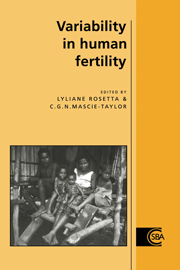Book contents
- Frontmatter
- Contents
- List of contributors
- 1 Introduction: the biological anthropological approach
- PART I HORMONAL ASPECTS OF FERTILITY REGULATION
- PART II INTERPOPULATION VARIABILITY
- PART III METABOLIC AND ENERGETIC ASPECTS OF REGULATION
- 8 Metabolic adaptation in humans: does it occur?
- 9 Possible adaptive mechanisms for energy saving during physical activity
- 10 Body composition and fertility: methodological considerations
- 11 Breast-feeding practices and other metabolic loads affecting human reproduction
- Index
10 - Body composition and fertility: methodological considerations
Published online by Cambridge University Press: 03 February 2010
- Frontmatter
- Contents
- List of contributors
- 1 Introduction: the biological anthropological approach
- PART I HORMONAL ASPECTS OF FERTILITY REGULATION
- PART II INTERPOPULATION VARIABILITY
- PART III METABOLIC AND ENERGETIC ASPECTS OF REGULATION
- 8 Metabolic adaptation in humans: does it occur?
- 9 Possible adaptive mechanisms for energy saving during physical activity
- 10 Body composition and fertility: methodological considerations
- 11 Breast-feeding practices and other metabolic loads affecting human reproduction
- Index
Summary
Introduction
Measurement of human body composition has become widespread in biological anthropology and in health-related studies. In studying variability in human fertility, investigators have wanted to measure the body composition, the lean: fat ratio; the minimum level of fatness; and the changing energy balance by serial measurements of body composition in adolescent girls and women of reproductive age to determine if these affect fertility. On many occasions, they want simple, inexpensive techniques suitable for the naive user, in the field. On other occasions, they may have a choice of laboratory methods available. The many implications of body composition states and the apparent simplicity of some of the measurements has led to the unquestioned use of techniques, particularly in field studies. However, the study of human body composition is complicated by methodological and biological issues, which are often conveniently put to one side in the heat of a survey or study and again when the results come to be interpreted.
This chapter considers the available body composition techniques and their applicability to the situations in which variability in human fertility is being investigated and to changing body composition in general. It considers the less known and forgotten measurement issues, rather than providing a comprehensive account of body composition methodology. The methods suitable for two types of use in fertility studies, field methods which have proven to be the most popular and laboratory methods used, for example, in studies of exercising women, are described.
- Type
- Chapter
- Information
- Variability in Human Fertility , pp. 167 - 194Publisher: Cambridge University PressPrint publication year: 1996



